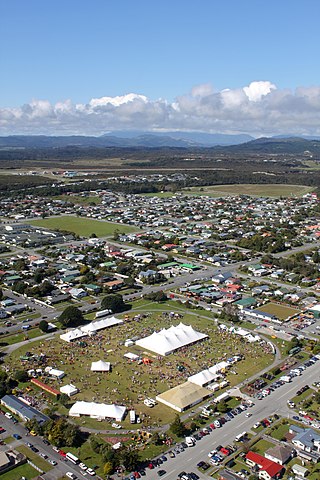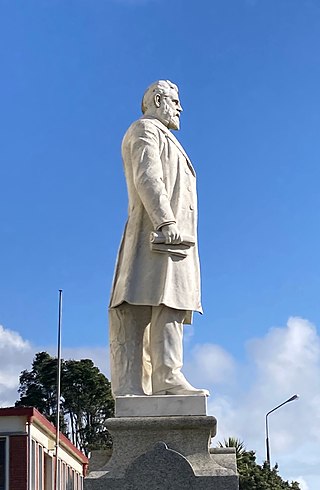
Hokitika is a town in the West Coast region of New Zealand's South Island, 40 kilometres (25 mi) south of Greymouth, and close to the mouth of the Hokitika River. It is the seat and largest town in the Westland District. The town's estimated population is 3,250 as of June 2024.

Ross is a small town located in the Westland District on the West Coast of New Zealand's South Island, 27 kilometres (17 mi) south-west of Hokitika and 46 kilometres (29 mi) north-east of Hari Hari by road.

Franz Josef is a small town in the West Coast region of the South Island of New Zealand. Whataroa is 32 kilometres (20 mi) to the north-east, and the township of Fox Glacier is 23 kilometres (14 mi) to the south-west. The Waiho River runs from the Franz Josef Glacier to the south, through the town, and into the Tasman Sea to the north-west.

Jacobs River is a locality in the West Coast region of the South Island of New Zealand, situated just to the north of where State Highway 6 crosses the Jacobs River. Bruce Bay is about 7 kilometres (4 mi) to the south-west, and Fox Glacier is almost 40 kilometres (25 mi) to the north-east, by road.
Hokitika is a former parliamentary electorate in the West Coast region of New Zealand, based on the town of Hokitika. It existed from 1871 to 1890 and was represented by nine members of parliament. For a time, it was one of the two-member electorates in New Zealand.

The Hokitika Wildfoods Festival is an annual event held in early March in Hokitika, New Zealand. Its main attraction is an array of unusual foods, including huhu grubs, lamb's testicles, and horse semen.
The Westland Boroughs by-election 1868 was a by-election held in the Westland Boroughs electorate during the 4th New Zealand Parliament, on 3 April 1868.
The Mayor of Hokitika officiated over the borough of Hokitika in New Zealand. The office was created in 1866 when Hokitika became a municipality and a borough two years later, and ceased with the 1989 local government reforms, when Hokitika Borough and Westland County merged to form Westland District. The first Mayor of Hokitika was James Bonar.

Westland County, also known as County of Westland, was a local government area on the West Coast of New Zealand's South Island. It existed from 1868 to 1873, and then from 1876 until 1989. In its first incarnation, it constituted the government for the area that was split from the Canterbury Province, with the West Coast gold rush having given the impetus for that split. It had the same administrative powers as a provincial council, but the legislative power rested with Parliament in Wellington. The first Westland County was the predecessor to Westland Province.

Hokitika Museum is a museum in Hokitika on the West Coast of the South Island in New Zealand, and is the West Coast's largest museum and archive. It is housed in the historic Hokitika Carnegie Library building. Exhibitions include information about the gold rush and the unique West Coast stone pounamu (greenstone) and its value to Māori. The museum also holds a significant photographic collection. Seismic strengthening requirements closed the museum in September 2019. According to the Westland District Council Web site as of December 2021 the museum had not yet reopened.

The Hokitika Clock Tower, initially called the Westland War Memorial and then the Coronation and War Memorial, is a prominent landmark in Hokitika, New Zealand. The memorial was initiated, fundraised for, and carried out by a committee, to commemorate the region's contribution to the Second Boer War; not just the four local men who had died but all 130 who had gone to war in South Africa. An additional purpose was to provide Hokitika with a town clock.

This statue of Richard Seddon is in Hokitika, on the West Coast of the South Island of New Zealand. The statue is situated on Sewell Street, outside the Government Buildings known as Seddon House.

All Saints' Church, also known as Hokitika Anglican Church, is an heritage-listed Anglican church located in Hokitika, on the West Coast of the South Island of New Zealand. The church forms part of the Ross and South Westland parish of the Diocese of Christchurch within the Anglican Church in Aotearoa, New Zealand and Polynesia. The church building is a Category I building on the Heritage New Zealand register.

Hokitika Gorge and the surrounding Hokitika Gorge Scenic Reserve are a major tourist destination some 33 kilometres (21 mi) or 40 minutes drive inland from Hokitika, New Zealand. Since August 2020, a second suspension bridge over the Hokitika River at the gorge provides the opportunity for a round track.

St Andrew's United Church, previously the Scot's Memorial Church, in Hokitika, New Zealand, is a Presbyterian/Methodist United church. It is a Category I registered building on the West Coast of New Zealand.

The Westland District Library is the public library in Hokitika, on the West Coast of New Zealand. Beginning as the Hokitika Literary Society in 1866, it occupied a Carnegie library building from 1908 as the Hokitika Free Public Library, moving out in 1975.
Arthur Reynolds Griffin was a New Zealand architect based in Nelson during the first half of the 20th century. His notable works include the Hokitika Carnegie Library, the church steps in Nelson (1913), and the Ritz Louis Kerr building (1930) in Nelson.

The West Coast Wildlife Centre is a kiwi-rearing facility in Franz Josef, New Zealand. A public-private partnership with the Department of Conservation and Te Rūnunga o Makaawhio of Ngāi Tahu, it hatches eggs of the kiwi species rowi and Haast tokoeka retrieved from the wild. It rears the chicks until they are large enough for transfer to outdoor enclosures as part of Operation Nest Egg. More than 50 per cent of all living rowi were hatched at the Wildlife Centre. It is also a tourist attraction with several captive tuatara, museum displays, and tours of the rearing facility.

The Hokitika Savings Bank building is a former bank building in Hokitika, on the West Coast of New Zealand's South Island. Completed in 1927, the building was granted historic place category 2 status by Heritage New Zealand in 1989.

Lewis Vernon Sanson is the former director of the New Zealand Department of Conservation.

















